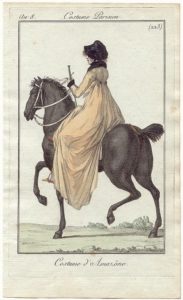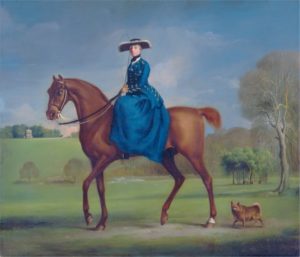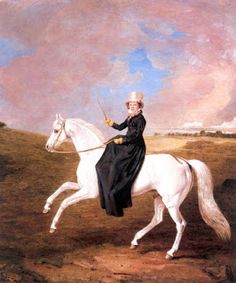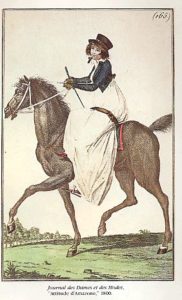Rid ing sidesaddle was the epitome of genteel upbringing for the Regency lady. It provided a convenient form of transportation, a good method of obtaining fresh air and exercise, and a great way to socialize–especially with gentlemen 😉 . Riding sidesaddle also effectively proclaimed one’s wealth and status. Sometime during the 17th Century, ladies started riding sidesaddle, also known as aside. Prior to that they rode astride or sat in an awkward riding seat and hung on for dear life.
ing sidesaddle was the epitome of genteel upbringing for the Regency lady. It provided a convenient form of transportation, a good method of obtaining fresh air and exercise, and a great way to socialize–especially with gentlemen 😉 . Riding sidesaddle also effectively proclaimed one’s wealth and status. Sometime during the 17th Century, ladies started riding sidesaddle, also known as aside. Prior to that they rode astride or sat in an awkward riding seat and hung on for dear life.
In order for a lady to be a good rider in Regency England, she had to have both time and money. She must take riding lessons, have time to practice the art of riding, and be wealthy enough to afford a horse trained as a lady’s mount. Work horses could simply graze; riding horses called for more expenses–a stable, feed, grooms, tack, farrier fees, etc. A lady competently riding aside, combined with a stylish riding habit, spoke louder than words of her social standing.
Riding habits were usually made by tailors, although some sources cite ladies dressmakers, or modistes, making riding habits, too. Riding habits included a fitted bodice with long sleeves, or sometimes a spencer, that fit well through the torso and shoulders. A long, full train covered the legs while riding. Regency ladies’ riding habits did not include a split skirt–those didn’t appear until the late Victorian Era. They seem to have come in a variety of fabrics, depending on weather, velvet being very popular.
Little girls were taught to ride astride on a pony or donkey. Then, as they grew in competence and size, they learned to a sidesaddle and usually graduated to a horse. This was a sign of skill and distinction. In urban areas, riding donkeys seemed to be pretty common, but riding in London seemed to require a beautiful horse, since in London, appearances became crucial.
Very few grown ladies rode astride in the city or country; not only was it unladylike and downright scandalous, it could be viewed as a declaration of one’s incompetence at riding side saddle.
Jane Austen herself didn’t learn to ride until nearly at the end of her life. Historians believe Jane had a fear of riding. If this is true, it may be due to a dear friend of the Austen family being killed while riding. Jane’s personal records cite this loss. It’s also possible that Jane didn’t ride in her youth because her family simply didn’t have the money for such a luxury. Most of her novels suggest a certain disapproval of ladies riding, and in a few cases, a touch of envy.

A common misconception about riding sidesaddle is that it was uncomfortable. In truth, it’s actually comfortable. The seat and pommel are both padded. In addition, one does not sit twisted, but rather with one’s back straight. It’s a lot like sitting in a chair with the right leg crossed over the left. I often sit sideways on the sofa with one knee propped up higher than the other. This is not much different than riding sidesaddle.
Others claim that riding aside is difficult. However, many women today who learn sidesaddle prefer it to astride. Both ways of riding are more about balance. When I ride astride, especially if the horse is large, I get sore in the soft tissue in my inner legs. Riding more frequently would help, I am sure, but sidesaddle would at least alleviate discomfort due to the girth of a horse.
Another myth is that it’s hard to get on a horse with a sidesaddle. Actually, one only needs a mounting block to mount a horse. Of course, having a handsome gentlemen nearby to give on a “leg up” is always welcome 🙂 Also, a trained lady’s mount stands very still for mounting or dismounting, they have a smooth gait, a light mouth, and are a pleasure to ride.
Many critics claim that it’s easy to fall off and therefore dangerous to ride aside. This is true of riding in general. Some riders, as my writer friend and horse expert Shannon Donnelly says, could fall off a merry-go-round horse; other riders can stay on anything–even a bucking bronco. Look at rodeo riders. They don’t rely on strength; they stay on by keeping their center of gravity over the horse. Again, riding is all about balance and skill whether a person rides astride or sidesaddle.
their center of gravity over the horse. Again, riding is all about balance and skill whether a person rides astride or sidesaddle.
Another common myth about riding aside is that one can’t gallop or jump. Again, this goes to skill–a skilled rider and well-trained horse can jump, gallop and do haute echole (dressage movements)–anything that can be done astride can also be done sidesaddle. There are numerous documented recordings of Georgian and Regency ladies riding side saddle as they “rode to hounds” which required a fast pace and much skill to charge through the country side after a pack of hounds chasing a fox.
 Riding sidesaddle is fun! Part of the trick is a well-trained horse. Some horses have a harder time adapting to his rider’s legs both on one side but others pick up on it quickly.
Riding sidesaddle is fun! Part of the trick is a well-trained horse. Some horses have a harder time adapting to his rider’s legs both on one side but others pick up on it quickly.
Now, like everything, the side saddle has evolved. However, the Regency side saddle was very similar to today’s side saddle. The main differences are that there was no no leaping horn, and the Regency stirrup is a ‘slipper stirrup’ which is different from today’s.
 Some images from the Regency Era show ladies riding with a sort of belt wrapped around them. It’s not clear to me if it’s attached to the saddle or not. It’s possible it was merely a way of keeping a lady’s skirts down flat, since I can’t imagine any woman would have secured herself to the saddle.
Some images from the Regency Era show ladies riding with a sort of belt wrapped around them. It’s not clear to me if it’s attached to the saddle or not. It’s possible it was merely a way of keeping a lady’s skirts down flat, since I can’t imagine any woman would have secured herself to the saddle.
Is today’s saddle safer? Probably. But many Regency ladies managed to ride anywhere they wanted, and as fast as they wanted, just fine, thank you very much.
Sources:
Much of this information came through years of research. However, some recent sources are:
Shannon Donnelly on Historical Hussies
Jill Ottman on the Jane Austen Centre of North America
Kathy Blee on Ladies Ride Aside

The comment I saw about the belt wasn’t as a seat belt , as some might think, but as a way to confine the skirt of the habit . The strap is not attached to the saddle.
Thank you for the clarification, Nancy!
What a great post, Lady Donna! 😉
Thank you, my lady. I’m honored you paid me a call 😉
Loved this post! I’ve always wanted to try riding aside, but I can barely stay on astride. But it sounds like it might be doable after all. I’ll be using this post as a reference as the heroine of one of my current WIPs is an excellent horsewoman and I’ll need descriptions of her riding.
Such an interesting post, Donna. I agree that balance would be the tricky part. I was reminded of the humorous scene in Auntie Mame when Mame survives a wild fox hunt because she got stuck in the side saddle. I always thought I would be able to ride like the wind (I watched too many Westerns, growing up ) but when I finally got atop a horse, I felt more like Shannon’s description–I could fall off a merry go round mount. 🙂
I have ridden both ways and to be honest I found the side saddle easier. This was because when riding astride I grip too tightly with my inner thighs (a fear reaction) and so have the potential to bounce around when cantering, hence my preference for galloping. However, when riding side saddle I am automatically sitting down in the saddle, and I can’t grip with my inner thighs. I LOVED cantering this way and felt much, much more secure.